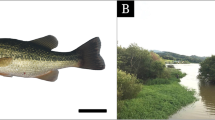Summary
The olfactory epithelium of the three-spined stickleback (Gasterosteus aculeatus) and the nine-spined stickleback (Pungitius pungitius) has been studied with a conventional histochemical and a novel immunological staining technique. In both species, the sensory epithelium is arranged in folds separated by non-sensory epithelial tissue. In the nine-spined stickleback, intrinsic folds consisting of non-sensory cells are found in the apical part of the sensory epithelium where they divide the surface of the sensory epithelium into small islets. These non-sensory cells are non-ciliated, flattened and piled on top of each other; they contain numerous electron-translucent vesicles. The intrinsic folds are absent from the sensory epithelium of the three-spined stickleback. In both species, axons of receptor cells form a layer of fibers in the sensory epithelium immediately above the basal cells. In the three-spined stickleback, thick branches of the olfactory nerve are frequently found in this layer. These branches are only occasionally observed in the sensory epithelium of the nine-spined stickleback. Thus, the three-spined stickleback and the nine-spined stickleback show considerable differences in the organization of the sensory regions of the olfactory epithelium.
Similar content being viewed by others
References
Bannister LH (1965) The fine structure of the olfactory surface of teleostean fishes. Q J Microsc Sci 106:333–342
Bertmar G (1973) Ultrastructure of the olfactory, mucosa in the homing Baltic sea trout, Salmo trutta trutta. Marine Biology 19:74–88
Coad BW (1981) A bibliography of the sticklebacks (Gasterosteidae: Osteichthyes). Syllogeus 35:1–142
Elofsson R, Hallberg E (1973) Correlation of ultrastructure and chemical composition of crustacean chromatophore pigment. J Ultrastruct Res 44:421–429
Getchell MI, Zielinski B, Getchell TV (1986) Ontogeny of the secretory elements in the vertebrate olfactory mucosa. In: Breipohl W (ed) Ontogeny of olfaction. Springer, Berlin Heidelberg New York, pp 71–82
Hallberg E, Reschke M (1990) The ultrastructural characteristics of the pheromone gland cells of Dendrolimus pini (Insecta: Lepidoptera). Acta Zool (Stockh) 71:169–172
Holl A (1965) Vergleichende morphologische und histologische Untersuchungen am Geruchsorgan der Knochenfische. Z Morphol Ökol Tiere 54:707–782
Honkanen T, Ekström P (1990) An immunocytochemical study of the olfactory projections in the three-spined stickleback, Gasterosteus aculeatus L. J Comp Neurol 292:65–72
Honkanen T, Ekström P (1991) An immunocytochemical study of the development of the olfactory system in the three-spined stickleback (Gasterosteus aculeatus L., Teleostei). Anat Embryol 184:469–477
Hudon J, Guderley H (1984) An electrophoretic study of the phylogenetic relationships among four species of sticklebacks (Pisces: Gasterosteidae). Can J Zool 62:2313–2316
Lewis DH, Tarpley RJ, Marks JE, Sis RF (1985) Drug induced structural changes in olfactory organ of channel catfish, Ictalurus punctatus, Rafinesque. J Fish Biol 26:355–358
Liermann K (1933) Über den Bau des Geruchsorgans der Teleostier. Z Anat Entwicklungsgesch 100:1–39
McLennan DA, Brooks DR, McPhail JD (1988) The benefits of communication between comparative ethology and phylogenetic systematics: a case study using gasterosteid fishes. Can J Zool 66:2177–2190
Penczak T (1961) Serological relationships between the nine-spined and the three-spined stickleback. Nature 192:673–674
Schulte E, Holl A (1971) Feinstruktur des Riechepithels von Calamoichthys calabaricus JA Smith (Pisces, Brachiopterygii). Z Zellforschung 120:261–279
Teichmann H (1954) Vergleichende Untersuchungen an der Nase der Fische. Z Morphol Ökol Tiere 43:171–212
Theisen B (1982) Functional morphology of the olfactory organ in Spinachia spinachia (L.) (Teleostei, Gasterosteidae). Acta Zool (Stockh) 63:247–254
Theisen B (1984) On the morphology of the olfactory organs in the Gasterosteidae (Teleostei) and related families. Videnskabelige meddelelser fra dansk naturhistorisk forening 145:87–96
Thommesen G (1983) Morphology, distribution and specificity of olfactory receptor cells in salmonid fishes. Acta Physiol Scand 117:241–249
Wootton RJ (1976) The biology of the sticklebacks. Academic Press, London New York San Francisco
Yamamoto M (1982) Comparative morphology of the peripheral olfactory organ in teleosts. In: Hara TJ (ed) Chemoreception in fishes. Elsevier, Amsterdam, pp 39–59
Yamamoto M, Ueda K (1978) Comparative morphology of fish olfactory epithelium. V. Gasterosteiformes, Channiformes and Synbranchiformes. Bull Jpn Soc Sci Fish 44:1309–1314
Author information
Authors and Affiliations
Rights and permissions
About this article
Cite this article
Honkanen, T., Ekström, P. Comparative study of the olfactory epithelium of the three-spined stickleback (Gasterosteus aculeatus) and the nine-spined stickleback (Pungitius pungitius). Cell Tissue Res 269, 267–273 (1992). https://doi.org/10.1007/BF00319617
Received:
Accepted:
Issue Date:
DOI: https://doi.org/10.1007/BF00319617




